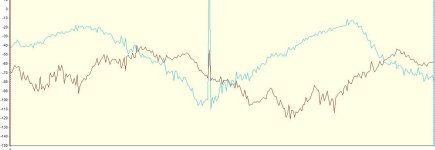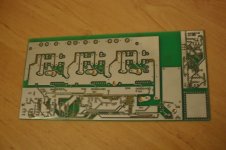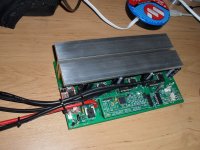h0tr0d said:
Teh Stork said:
I found my efficiency 'sweet spot' around 160kHz. There conduction losses is about 1/2, switching losses about 2/6 and 'stray' losses 1/6.
Didn't quite understand your numbers, care to elaborate?
Conduction losses; R*I^2. On state resistance times phase current squared. Stands for 50% of losses.
Switching losses; 0,5*C*V^2*freq. Fet capacitance times voltage squared halved (energy in capacitor) times freq. I take this value and triple it. This gives a ballpark figure for switching losses - 'Eon' 'Eoff'. This closely matches my measured values. Stands for ~30% of losses.
'Stray losses'. Power supply to gate drivers (10V) inefficiency (the efficient power converted is within switching losses). Current ripple * DF (is quite high actually). Stands for 20% of losses.
To test these parameters I used two weeks to build equipment specifically suited to testing the parameters. Among the things I'm proud of is:
- 3kW purely resistive load (boils water) (used to test conduction losses mostly).
- Inductor bank, low stray capacitance optimized. Made from silicon steel, as you often find in motors. Outfitted with thermocouples to monitor iron losses (Six step generates way more iron losses than FOCSVPWM).
- Current ripple load generator. A load to test how the input capacitors of the inverter react to current ripple.
By combining the purely resistive load and current ripple generator I can keep a constant on time of the fets - this eliminates the switching losses, so I can look at the 'Stray' losses outside switching losses. And I can separate the switching losses better from the other losses.
I understand you want to offer controllers hotrod, but there is more to it than meets the eye. Say you have a complete BOM for the pcb and components that go onto it. Still you must at least double it to account for enclosure, water proofing, cabling and the like. Then comes testing, assembly and packaging. There is a reason why high-end inverters are expencive, they are not mass-produced.
I have a dream to launch my own high-end ebike by the end of my masters studies (2 yrs). I already have batteries, controller and 'cycle analyst' down, I need to optimize the rest of the bike before I can offer it (motor, drivetrain, frame, rims, and the like). The price here in norway will be 5000-7000 dollars, but that is what it will cost if I am to have food on my table. I plan to offer parts kits for DIY'ers on the side, still I won't be competetive with china products. Nor do I want to, making shit that lasts sub 5 years can be continued to be made in china. The 'life cost' of my product will be better anyhow, too bad people only care about upfront costs.
(Extremely off topic on the end there, sorry xD )





